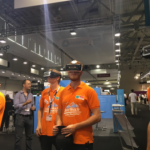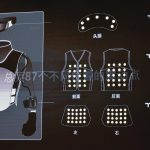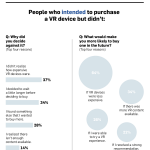How Consumers Perceive Virtual Reality [Infographic]
— May 4, 2017
![How Consumers Perceive Virtual Reality [Infographic]](https://www.devicedaily.com/wp-content/uploads/2017/05/How-Consumers-Perceive-Virtual-Reality.png)
This past December, a research-based consultancy asked two groups of 1,000 people ages 18-64 about virtual reality (VR) devices and how devices fit into their holiday shopping plans. In January, they followed up with consumers to see if wish lists became reality. Now, those survey results are available, having recently been published in AdWeek under the headline, “Reality Bites.”
As the header might suggest, it seems virtual reality just isn’t quite there yet. Many consumers are interested in the products and open to buying them, but when it comes time to separate with their cash… well, the majority seem to be holding out for better products at lower price points. Let’s take a closer look at some of the data…
Types of VR Headsets
The study focused on four types of VR headsets:
- VR headset that works with any smartphone (Priced at $ 15, Google Cardboard is a readily available entry-level product, though there are many pricier and more sophisticated options that can work with any smartphone.)
- PlayStation VR headset
- VR headset designed for a specific smartphone
- VR headset that connects to your PC
25% of respondents said they intended to purchase a VR headset that works with any phone, while only 14% actually did so. What made this group (and all the other groups) decide against their original purchase decision?
Why did you decide against your purchase?
- “I didn’t realize how expensive VR devices were.” – 37%
- “I decided to wait a little longer before deciding to buy.” – 34%
- “I found something else that I wanted to buy more.” – 28%
- “I realized there isn’t enough content available.” – 14%
What would make you more likely to buy a VR device in the future?
- 64%: if VR devices were less expensive.
- 34%: if there was more VR content available.
- 26%: if I were able to try a VR experience.
- 22%: if I received a strong recommendation.
Feedback from People Who Purchased VR Device
When asked how did the VR device you purchased perform given your expectations of the device, the majority of people said, “Far better than my expectations.” Not only that, but 91% of respondents (across all four categories of VR devices) said that their device at least performed “as well as I expected it to.”
This is a strong indicator for the future of VR. If these early stage devices are meeting and exceeding consumer expectations at such a high level, then it’s likely only a matter of time before additional users join them. For now, the primary problems are overcoming high costs and creating enough content to support the platforms.
Do You Have a VR Device?
If so, what do you like about it? What do you not like about it? Tell us in the comments section below!
![How Consumers Perceive Virtual Reality [Infographic]](https://www.devicedaily.com/wp-content/uploads/2017/05/How-Consumers-Perceive-Virtual-Reality-Infographic.png)
Digital & Social Articles on Business 2 Community
(68)

![How Consumers Perceive Virtual Reality [Infographic]](https://www.devicedaily.com/wp-content/uploads/2017/05/How-Consumers-Perceive-Virtual-Reality-Infographic-520x1973.png)











